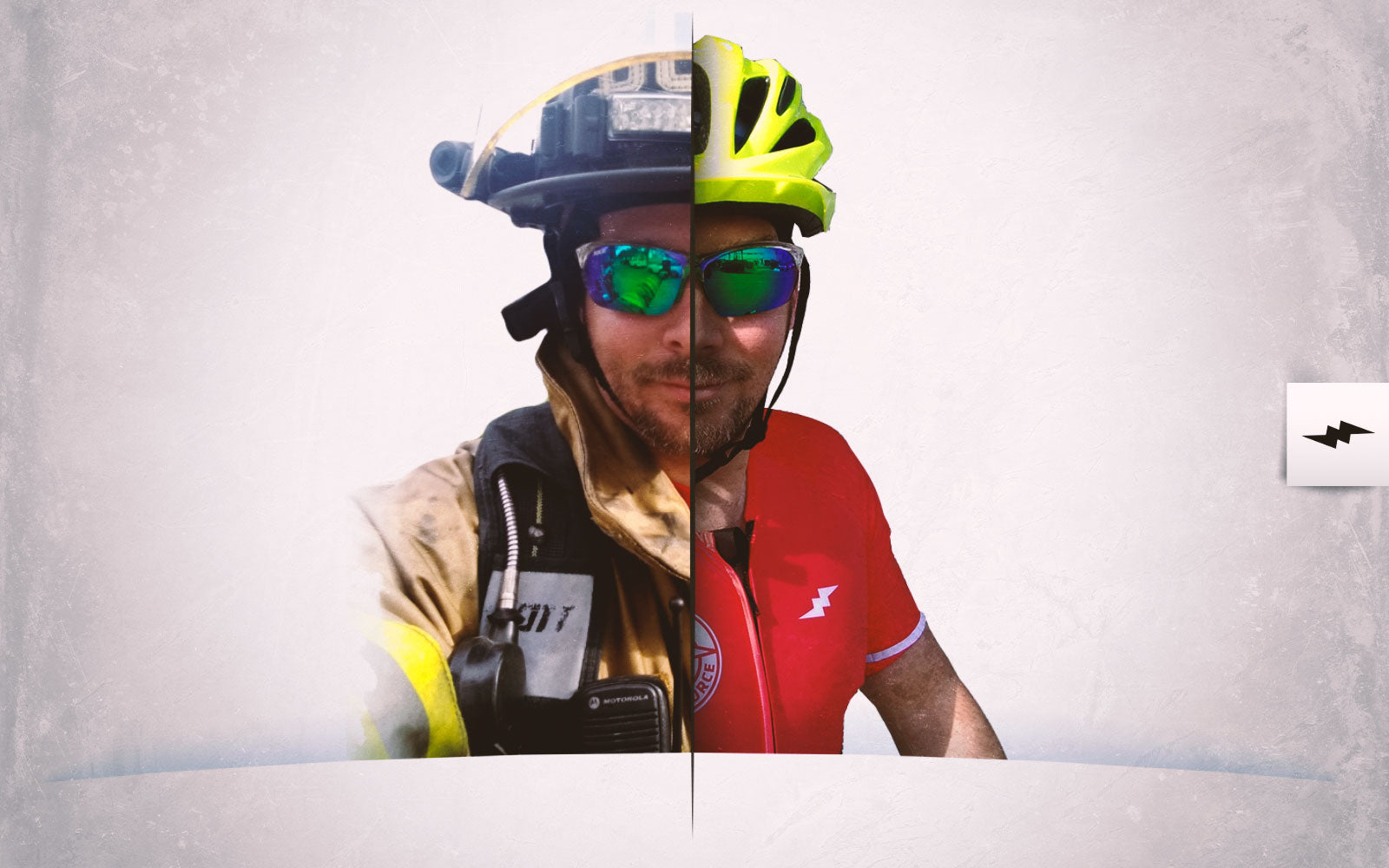How To Balance Work And Training

There is no way around it; training for endurance events takes time. As a recreational soccer player, it is highly possible to get in just one hour of training in per week and then turn up for the match on Sunday and perform at a decent enough level to have fun. Try that for a marathon, for example, and you will be setting yourself up for failure. An average training plan for a marathon will last from 16-20 weeks and you’ll be running 3-5 times a week. So this begs the question; How do you balance the amount of training needed and your work commitments without burning out?
Some tips to help you to be able to commit to training while holding down a 9-5 job are to prioritize your daily activities in order to cut out wasted time, and to be adaptable with your training methods so that you can fit them into the time you have available. Combine activities wherever possible; the most obvious one is to bike to work, and remember that there are 24 hours in the day so get used to training at odd hours.
Cut Out Wasted Time

Be honest, how much time do you spend mindlessly surfing pictures of what your friends have eaten for breakfast, or some other such banal social media post? In 2020, the average time spent on social media in the U.S. was two hours and three minutes!
No matter what type of event you are training for, here is a great activity you can do in order to show yourself how much time you actually have in the day which is being frittered away. Take one day to write down exactly what you do and how long you spend doing it. That includes the morning shower, breakfast, catching up on the morning news, through to meetings, reports, emails and bed-time stories. Write the lot down and then see how many of those activities are not essential, or are taking up too much time.
The easiest ones to cut out are the YouTube and Facebook ‘breaks’, but also take a look at how much time you are spending at work on low-value emails or requests. It might be that you need to work on your delegating skills to allow you to actually leave the office at 5pm.
Be Flexible In Your Training
Readily-available online training programs are a godsend for endurance athletes. No longer do we need to grope around in the dark, hoping that the time we are putting in is enough to get us through the events we have signed up for. Now we have a multitude of training programs we can choose from that guide us through exactly how we should be training; time, distance and intensity.
This is all well and good, but many of these programs seem to have been written for people with zero social life and very consistent working hours. The truth is that there are times when meetings drag on longer than intended, we are called in to deal with unexpected ‘emergencies’ and the like. When those things happen have you ever tried saying to your boss ‘Sorry but I have to dash; I have a scheduled 15km zone 2 run this evening. See you in the morning.’? Probably not a good option.
Rather than sitting there clock-watching and seething that this ridiculous meeting is destroying your perfectly planned training week, be flexible. Think about how you can use this to your advantage.
Ok, so you won’t have the 2 hours that you were hoping for so go and check out that local hill that you always think would be great for hill sprints (if only your sacred plan had included those). Take the 20 minutes, or whatever you have remaining, and get a yoga flow session in or an ab-burning workout.
The truth is that things rarely go according to plan during a race, and life is like that too. If you do not learn to be flexible in your training then you are likely to end up stressed out and resentful of other people ‘taking away’ your time to train.
Combine Activities
When I was training for my first half-Ironman, cycling to work was a powerful addition to training. In the morning I used it as a muscle recovery workout and took things nice and easy. It also allowed me half an hour away from everything; it was a quiet space before the work day started and I found that a lot of solutions appeared on those rides quite unexpectedly.
The ride home was used for more intense work. Mini-HIIT sessions, single-leg power rides and the like. There was no structure to this either; I gave myself the freedom to work on the things I wanted to, and to try out new ideas that I had read about. I had to commute anyway, so why not make is part of my training?
Make simple changes such as always taking the stairs, or taking 1-2-1 meetings outside and turning them into walking meetings. These changes can all add up and help towards your personal goals, as well as fuelling your creative mind.
If you are working from home then indoor trainers, be they for cycling or running, allow for time to be spent on other activities while you are training. Sure, you may not be able to chair a meeting while you are training but you can still read through reports, go through meeting minutes, and other more passive activities.
Train At Unusual Hours

For many of us, by the time we have finished work for the day, commuted home (by bike or foot), done the food shopping and cooked dinner we are simply ready for bed. The idea alone of facing a heavy training session is enough to make us groan. So go to bed. Grab yourself 3 hours sleep and get up at 10pm for a night-time training session.
The advantage of training at this hour is that the streets are so much quieter. Less traffic for you to negotiate on the bike and less noise so you can actually find some peace on your runs.
If you are more of a morning person, then set your alarm for 3am and get out for a couple of hours while the rest of the world is at rest. It is amazing how much more training you can fit in when you start to become comfortable using the nocturnal hours.
Final Thoughts
Finding the time to train for any kind of endurance event and holding down a full-time job at the same time is a challenge, but rest safe in the knowledge that you are among the vast majority. Very few of the other competitors lining up on race day will be professional athletes; most will be just like you. Be creative and flexible in your training and be more aware of how you are using your time and this will go a long way in helping you achieve the balance between work and training that you are looking for.
Many of the ideas in this article lend themselves to solo-training, so if you haven’t read it yet then check out our article on ‘Solo Training; What You Gain By Training Alone’.
Written for Innerforce by Stewart Spiessens
Photos. @raypencetri

There is no way around it; training for endurance events takes time. As a recreational soccer player, it is highly possible to get in just one hour of training in per week and then turn up for the match on Sunday and perform at a decent enough level to have fun. Try that for a marathon, for example, and you will be setting yourself up for failure. An average training plan for a marathon will last from 16-20 weeks and you’ll be running 3-5 times a week. So this begs the question; How do you balance the amount of training needed and your work commitments without burning out?
Some tips to help you to be able to commit to training while holding down a 9-5 job are to prioritize your daily activities in order to cut out wasted time, and to be adaptable with your training methods so that you can fit them into the time you have available. Combine activities wherever possible; the most obvious one is to bike to work, and remember that there are 24 hours in the day so get used to training at odd hours.
Cut Out Wasted Time

Be honest, how much time do you spend mindlessly surfing pictures of what your friends have eaten for breakfast, or some other such banal social media post? In 2020, the average time spent on social media in the U.S. was two hours and three minutes!
No matter what type of event you are training for, here is a great activity you can do in order to show yourself how much time you actually have in the day which is being frittered away. Take one day to write down exactly what you do and how long you spend doing it. That includes the morning shower, breakfast, catching up on the morning news, through to meetings, reports, emails and bed-time stories. Write the lot down and then see how many of those activities are not essential, or are taking up too much time.
The easiest ones to cut out are the YouTube and Facebook ‘breaks’, but also take a look at how much time you are spending at work on low-value emails or requests. It might be that you need to work on your delegating skills to allow you to actually leave the office at 5pm.
Be Flexible In Your Training
Readily-available online training programs are a godsend for endurance athletes. No longer do we need to grope around in the dark, hoping that the time we are putting in is enough to get us through the events we have signed up for. Now we have a multitude of training programs we can choose from that guide us through exactly how we should be training; time, distance and intensity.
This is all well and good, but many of these programs seem to have been written for people with zero social life and very consistent working hours. The truth is that there are times when meetings drag on longer than intended, we are called in to deal with unexpected ‘emergencies’ and the like. When those things happen have you ever tried saying to your boss ‘Sorry but I have to dash; I have a scheduled 15km zone 2 run this evening. See you in the morning.’? Probably not a good option.
Rather than sitting there clock-watching and seething that this ridiculous meeting is destroying your perfectly planned training week, be flexible. Think about how you can use this to your advantage.
Ok, so you won’t have the 2 hours that you were hoping for so go and check out that local hill that you always think would be great for hill sprints (if only your sacred plan had included those). Take the 20 minutes, or whatever you have remaining, and get a yoga flow session in or an ab-burning workout.
The truth is that things rarely go according to plan during a race, and life is like that too. If you do not learn to be flexible in your training then you are likely to end up stressed out and resentful of other people ‘taking away’ your time to train.
Combine Activities
When I was training for my first half-Ironman, cycling to work was a powerful addition to training. In the morning I used it as a muscle recovery workout and took things nice and easy. It also allowed me half an hour away from everything; it was a quiet space before the work day started and I found that a lot of solutions appeared on those rides quite unexpectedly.
The ride home was used for more intense work. Mini-HIIT sessions, single-leg power rides and the like. There was no structure to this either; I gave myself the freedom to work on the things I wanted to, and to try out new ideas that I had read about. I had to commute anyway, so why not make is part of my training?
Make simple changes such as always taking the stairs, or taking 1-2-1 meetings outside and turning them into walking meetings. These changes can all add up and help towards your personal goals, as well as fuelling your creative mind.
If you are working from home then indoor trainers, be they for cycling or running, allow for time to be spent on other activities while you are training. Sure, you may not be able to chair a meeting while you are training but you can still read through reports, go through meeting minutes, and other more passive activities.
Train At Unusual Hours

For many of us, by the time we have finished work for the day, commuted home (by bike or foot), done the food shopping and cooked dinner we are simply ready for bed. The idea alone of facing a heavy training session is enough to make us groan. So go to bed. Grab yourself 3 hours sleep and get up at 10pm for a night-time training session.
The advantage of training at this hour is that the streets are so much quieter. Less traffic for you to negotiate on the bike and less noise so you can actually find some peace on your runs.
If you are more of a morning person, then set your alarm for 3am and get out for a couple of hours while the rest of the world is at rest. It is amazing how much more training you can fit in when you start to become comfortable using the nocturnal hours.
Final Thoughts
Finding the time to train for any kind of endurance event and holding down a full-time job at the same time is a challenge, but rest safe in the knowledge that you are among the vast majority. Very few of the other competitors lining up on race day will be professional athletes; most will be just like you. Be creative and flexible in your training and be more aware of how you are using your time and this will go a long way in helping you achieve the balance between work and training that you are looking for.
Many of the ideas in this article lend themselves to solo-training, so if you haven’t read it yet then check out our article on ‘Solo Training; What You Gain By Training Alone’.
Written for Innerforce by Stewart Spiessens
Photos. @raypencetri
SEE WHAT CUSTOM APPAREL LOOKS LIKE

GEAR UP
MORE FROM THE BLOG

How to Plan Your 2019 Season to Put Your Hard Training to Good Use
Team Innerforce's 2019 coach, Rick Lapinski, explains how to effectively plan your race schedule in order to get the most...

Breakfasts to fuel your bike session
To bike well, one has to eat well. Early morning sessions are always tough, but focussing on a good...

Innerforce Signs Kayla Kobelin: "I'm excited to to push myself even further"
It is with great pride that we, at Innerforce, welcome Kayla Kobelin to the Innerforce family as our first sponsored...

Triathlete Nutrition: What to Eat to Maximize Performance
Nutrition is crucial in any sport but for a multi-faceted discipline like triathlon, which tests your swimming, cycling and running...



